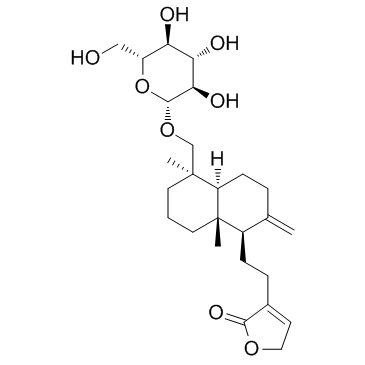Inhibition of proprotein convertases-1, -7 and furin by diterpines of Andrographis paniculata and their succinoyl esters.
A Basak, S Cooper, A G Roberge, U K Banik, M Chrétien, N G Seidah
Index: Biochem. J. 338 ( Pt 1) , 107-13, (1999)
Full Text: HTML
Abstract
Studies were performed to investigate the prohormone/proprotein convertase (PC)-inhibitory properties of chemical constituents of the medicinally active plant Andrographis paniculata (AP; from the family Acanthaceae), also known as 'King of Bitters'. Among the individual components tested against the clinically important convertases, furin and PC1, neoandrographolide (a C3 O-glucoside derivative of the major constituent andrographolide) exhibited the highest inhibitory action with an IC50 of 53.5 microM against furin. The data further revealed that although andrographolide, the major bitter principle of AP, exhibited a relatively small enzyme inhibition (IC50=1.0 mM and Ki=200 microM against furin), upon succinoylation, its inhibitory action against the above convertases was enhanced significantly with a Ki in the low micromolar range (<30 microM), suggesting that a specific structural modification of the andrographolide skeleton may be exploited to develop a new class of non-peptide inhibitors of PCs. When tested against PC7, these succinoylated derivatives of andrographolide also displayed strong inhibitory action, with Ki values again in the low micromolar range. This potentially interesting observation may be attributed to the reported anti-HIV property of 14-dehydroandrographolide succinic acid monoester (DASM). It is suggested here that DASM, by virtue of this protease inhibitory property, possibly acts by suppressing the proteolytic cleavage of envelope glycoprotein gp160 of HIV, which is known to be PC-mediated, particularly by furin and PC7.
Related Compounds
| Structure | Name/CAS No. | Molecular Formula | Articles |
|---|---|---|---|
 |
Neoandrographolide
CAS:27215-14-1 |
C26H40O8 |
|
Antihepatotoxic effects of major diterpenoid constituents of...
1993-07-06 [Biochem. Pharmacol. 46(1) , 182-5, (1993)] |
|
Study of anti-inflammatory activities of the pure compounds ...
2010-11-01 [Int. Immunopharmacol. 10(11) , 1361-73, (2010)] |
|
Quantitative analysis of four major diterpenoids in Androgra...
2012-11-01 [J. Pharm. Biomed. Anal. 70 , 87-93, (2012)] |
|
Inhibitory effects of neoandrographolide on nitric oxide and...
2007-04-01 [Mol. Cell Biochem. 298(1-2) , 49-57, (2007)] |
|
Microbial transformation of neoandrographolide by Aspergillu...
2007-01-01 [J. Asian Nat. Prod. Res. 9(3-5) , 463-9, (2007)] |